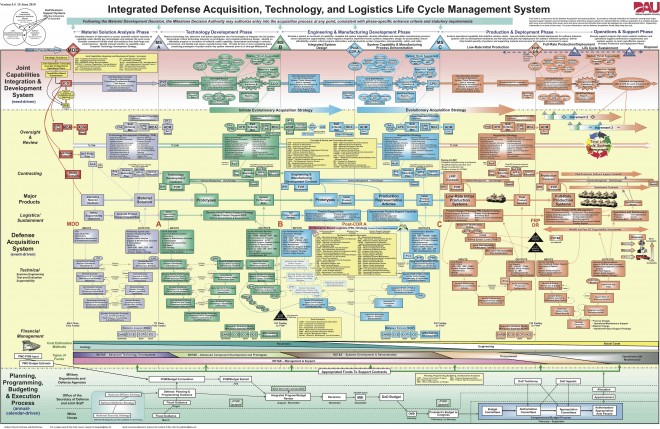Those of you who have read some of my previous musings know that I have a bee in my bonnet about Pentagon “Double Speak.” You know… the overly complicated buzzwords and phrases for simple things. Here’s a link to one of my articles that has some examples. A few of my favorites include:
- New Presence Paradigm: Overseas Bases
- Hybrid Contingencies: Kludges
- Proxy Groups: Terrorists
- Dynamic Environment: The Real World
- Asymmetric Approaches: More with less
- Rebalance Tooth-to-Tail: Cut contractors
- Win Decisively: Win
- Rebalance: Cut
- “Opportunity, Growth, and Security” Initiative: Slush Fund
- Innovation: Not in DoD dictionary
- Multi-lateral Security Architecture: Treaty
- Force Planning Construct: Size
- Efficiencies: Negative Budget Wedges
As I was reading the news this morning, I found this article on the name change of the “Air Sea Battle” concept in DoD Buzz. So forget about Air-Sea Battle and let me introduce you to Joint Concept for Access and Maneuver in the Global Commons! True to form, the Joint Staff has managed to take a relatively simple name and complicate it to the point of non understanding. Of course what would a new concept be without its accompanying acronym, JAM-GC? I suppose the pronunciation will be JAM-Jic or something like that. I can here the conversation in the Pentagon Food Court now, “What are you working on now?”….”Oh, I’m now the JAM-Jic lead and believe you me there’s lots of jamming and jickin to be done now that this Air-Sea thing has vaporized.”
So, I was never a fan of the Air-Sea Battle thing. IMHO, it was just a budget ploy by the Air Force ( and a somewhat reluctant Navy) to show relevance in an era where it’s relevance was waning. It’s not the first time the Air Force, after becoming alarmed by increasing dependence on and relevance of naval forces, began to seek ways to move into Navy mission territory. This always puzzled me, because in my mind it’s always be a air-sea-land battle. Especially as the perceived budget pressures have forced all the Services to cut force structure. In any serious and protracted campaign, the Navy needs Air Force tanking and command and control capabilities. And the Air Force relies on the assets from the Navy with little or no support requirements to beef up the Joint Force. It was never clear to me why Air Force and Navy needed to invent a “new concept” for something that has always existed….except for the issue of the Joint Strike Fighter. This $160 Billion over-budget, 7 year-late program is costing the King’s treasure and consuming all other aspects of the budgets of both services. Why not influence operational concepts as well? The story line? Air Force and Navy are inextricably linked by the Air-Sea Battle Concept and we must have the JSF to make it work. To the Hawks on the Hill, this can be a very compelling argument. One wonders what was going through the minds of the Army folks while they watched this little menage a deux develop.
Well, I guess the Army dusted things up enough to cause a name change, albeit no less threatening to their budget. As they say in the Patriot’s locker room, “All’s fair in love and war!” So to appease the Army, it appears we now have a new concept. And the name is a doozy…..Joint Concept for Access and Maneuver in the Global Commons.  Access is there to appease the Air Force and Navy, while Maneuver is there to keep the Army below the horizon of the doctrinal landscape.
Access is there to appease the Air Force and Navy, while Maneuver is there to keep the Army below the horizon of the doctrinal landscape.
I have to comment that the new name doesn’t do much for me…..especially the Global Commons piece. To this dinosaur, Global Commons is just a hoity-toity pretentious way for the Pentagon illuminati to show how deep their thoughts are. What is/are the Global Commons? Here’s what Wikipedia says:
a term typically used to describe international, supranational, and global resource domains in which common-pool resources are found. Global commons include the earth’s shared natural resources, such as the deep oceans, the atmosphere, outer space and the Northern and Southern polar regions, the Antarctic in particular. Cyberspace may also meet the definition of a global commons.
I am assuming that in the context of the Pentagon’s understanding, global commons to us unenlightened means “the places we want to be, that others don’t want us to be.” My suggestion for the name of the concept would be the “Enter, Conquer,Stay, Operate” Concept, ECSO or EkSo. It’s sooooo much nicer than Jam-Jic, Don’t you think?
Anyway, as we face serious and deadly threats from everywhere and everything, Syria, Afghanistan, ISIS/L,Budgets, cyber, meteorites, ebola, global warming, etc., it’s good to know we still have thinkers working on US access and maneuver in the Global Commons.







 It’s the world where everything is backwards….the name of the bizarro world planet is Htrae (so clever!) and the world is square. As I recall, it was featured occasionally in Superman comics in the 1960’s. One of the mottos in Bizarro World was ” Us do opposite of all earthly things.” Bizarro bonds were a hot item on Htrae because they were “guaranteed to lose money.” So I don’t think it’s a huge stretch to make the analogy here.
It’s the world where everything is backwards….the name of the bizarro world planet is Htrae (so clever!) and the world is square. As I recall, it was featured occasionally in Superman comics in the 1960’s. One of the mottos in Bizarro World was ” Us do opposite of all earthly things.” Bizarro bonds were a hot item on Htrae because they were “guaranteed to lose money.” So I don’t think it’s a huge stretch to make the analogy here. A few days after the decision was made, the staff came back and noted that since we slid the ship a year, it’s going to cost more…..I don’t remember how much, but it was around $100 Million or so. “Really?” I commented. ‘Oh, yes,” came the reply, ” money will cost more the next year, we have shipyard loading issues that we will have to pay for, the cost of steel is going up, blah, blah blah.” So I began to understand that the economics of shipbuilding were different. I formulated The Shipbuilding Entropy Rule: “Nothing ever costs less. NO matter what you do, it will always cost more.” You buy less, they cost more. You cancel the buy, you still have to pay the overhead. You remove capability, it costs more to redo drawings. Its all very counter-intuitive. This became very clear to me during the following year’s budget build when the staff came back and said “We made a mistake. We have to move the LMSR back to the original purchase year.” “Fine,” I replied, “No harm, no foul.” Sensing it wasn’t “Fine“, based on the furtive glances between the staffers (an admiral sees a lot of those looks in the Pentagon) I asked “What’s wrong?” Turns out, if we moved the ship back into the original purchase year, it added another $100 Million to the cost! Whadakknow? We essentially did nothing and paid $200 Million not to do it! That, my friends, is Bizarro accounting!
A few days after the decision was made, the staff came back and noted that since we slid the ship a year, it’s going to cost more…..I don’t remember how much, but it was around $100 Million or so. “Really?” I commented. ‘Oh, yes,” came the reply, ” money will cost more the next year, we have shipyard loading issues that we will have to pay for, the cost of steel is going up, blah, blah blah.” So I began to understand that the economics of shipbuilding were different. I formulated The Shipbuilding Entropy Rule: “Nothing ever costs less. NO matter what you do, it will always cost more.” You buy less, they cost more. You cancel the buy, you still have to pay the overhead. You remove capability, it costs more to redo drawings. Its all very counter-intuitive. This became very clear to me during the following year’s budget build when the staff came back and said “We made a mistake. We have to move the LMSR back to the original purchase year.” “Fine,” I replied, “No harm, no foul.” Sensing it wasn’t “Fine“, based on the furtive glances between the staffers (an admiral sees a lot of those looks in the Pentagon) I asked “What’s wrong?” Turns out, if we moved the ship back into the original purchase year, it added another $100 Million to the cost! Whadakknow? We essentially did nothing and paid $200 Million not to do it! That, my friends, is Bizarro accounting! They became so expensive and the requirements bounced around so much, we began advertising it as a fire support ship vital to the survival of the Marines during amphibious assaults. As such, we only needed about 10-12, just enough to support the number of amphibious ready groups (ARGS) we had at the time. The Marines were happy about that, even though they preferred to have 2 per ARG. I even went over to the Hill with my Marine counterpart extolling the virtues of the DDG-21 as the perfect fire support ship for the Marines. But once the Marines realized that the cost of the ship was so high that it would probably limit the amount of other stuff they could buy, they dropped it like a hot potato…..they would much rather have the 360 V-22’s than 24 DD(X)’s. So in the space of about a month we changed our tune from”vital” to “not so vital.” Now that they are $3 Billion a copy, we are only building 3 of them and I’m not sure there’s a real requirement out there. As my Grandmother said when she got her first taste of champagne in one of those dinky champagne flutes at my son’s baptism, “That’s not enough to wet my whistle.” So it is with DDG-1000 IMHO. The real requirement as far as I can tell is to have something for Bath Iron Works to build ( they will build all three) so they can stay in business in order to address industrial base concerns. Hence the title of the article.
They became so expensive and the requirements bounced around so much, we began advertising it as a fire support ship vital to the survival of the Marines during amphibious assaults. As such, we only needed about 10-12, just enough to support the number of amphibious ready groups (ARGS) we had at the time. The Marines were happy about that, even though they preferred to have 2 per ARG. I even went over to the Hill with my Marine counterpart extolling the virtues of the DDG-21 as the perfect fire support ship for the Marines. But once the Marines realized that the cost of the ship was so high that it would probably limit the amount of other stuff they could buy, they dropped it like a hot potato…..they would much rather have the 360 V-22’s than 24 DD(X)’s. So in the space of about a month we changed our tune from”vital” to “not so vital.” Now that they are $3 Billion a copy, we are only building 3 of them and I’m not sure there’s a real requirement out there. As my Grandmother said when she got her first taste of champagne in one of those dinky champagne flutes at my son’s baptism, “That’s not enough to wet my whistle.” So it is with DDG-1000 IMHO. The real requirement as far as I can tell is to have something for Bath Iron Works to build ( they will build all three) so they can stay in business in order to address industrial base concerns. Hence the title of the article. regarding the relief of 16 Air Force officers
regarding the relief of 16 Air Force officers Back to the nuke thing. One thing I knew as an Attack Squadron Commanding Officer: The quickest way to be relieved without question was to score anything other than an outstanding on nuke inspections. Consequently, I put my absolute best officers and enlisted personnel in those positions. I assume the same is true in the Air Force, so that the absolute best must be assigned nuclear positions. In that business, there is no room for error. Obviously some house cleaning was needed and the Air Force leadership did what they had to do.
Back to the nuke thing. One thing I knew as an Attack Squadron Commanding Officer: The quickest way to be relieved without question was to score anything other than an outstanding on nuke inspections. Consequently, I put my absolute best officers and enlisted personnel in those positions. I assume the same is true in the Air Force, so that the absolute best must be assigned nuclear positions. In that business, there is no room for error. Obviously some house cleaning was needed and the Air Force leadership did what they had to do. Second was the publishing of a report by the Senate Permanent Subcommittee on Investigations, Chaired by Senator Levin, with Senator McCain as the Ranking Member. The report, entitled “
Second was the publishing of a report by the Senate Permanent Subcommittee on Investigations, Chaired by Senator Levin, with Senator McCain as the Ranking Member. The report, entitled “

 In just a few days, all the big accounting firms that do business with DoD will be submitting proposals to conduct audits of the the Army, Navy and Air Force Statements of Budgetary Activity (SBA)……that’s a high level balance sheet that has little applicability to the actual management of anything. Experience in auditing the Marine Corps proved that trying to do anything else was futile. One just has to read the Reuters article on “Plugs” to see just how daunting a task auditing any of the services really is. Inventing phantom ledger entries or “plugs” to explain away imbalances in the “goes-intas” and the “goes-outtas” is apparently the norm at the Defense Finance and Accounting Service. What’s a little disturbing about this whole audit thing, is that many of these sins will go unexamined because they do not necessarily impact the SBA. See my article “
In just a few days, all the big accounting firms that do business with DoD will be submitting proposals to conduct audits of the the Army, Navy and Air Force Statements of Budgetary Activity (SBA)……that’s a high level balance sheet that has little applicability to the actual management of anything. Experience in auditing the Marine Corps proved that trying to do anything else was futile. One just has to read the Reuters article on “Plugs” to see just how daunting a task auditing any of the services really is. Inventing phantom ledger entries or “plugs” to explain away imbalances in the “goes-intas” and the “goes-outtas” is apparently the norm at the Defense Finance and Accounting Service. What’s a little disturbing about this whole audit thing, is that many of these sins will go unexamined because they do not necessarily impact the SBA. See my article “ Stay tuned, but I think with sequestration about to raise its head once again, the President under pressure to mount military responses to multiple spots around the globe, and political stalemate in the Congress, betting on continued funding for DoD audits is at best like wagering on red or black at the roulette wheel at Trump Towers in Atlantic City (ooppppsss, it’s out of business, so how about The Nugget in Las Vegas?).
Stay tuned, but I think with sequestration about to raise its head once again, the President under pressure to mount military responses to multiple spots around the globe, and political stalemate in the Congress, betting on continued funding for DoD audits is at best like wagering on red or black at the roulette wheel at Trump Towers in Atlantic City (ooppppsss, it’s out of business, so how about The Nugget in Las Vegas?). I’m not surprised at that because given the irrational focus of DoD on vendor profits, they have managed to make bidding on defense contracts so unattractive that fewer and fewer companies are making the effort to bid. In my view, it’s not just one reason:
I’m not surprised at that because given the irrational focus of DoD on vendor profits, they have managed to make bidding on defense contracts so unattractive that fewer and fewer companies are making the effort to bid. In my view, it’s not just one reason:
